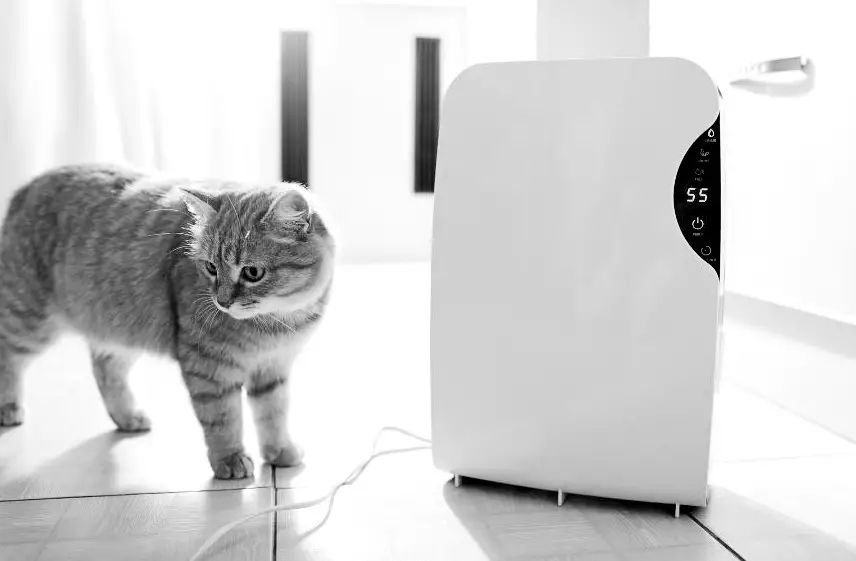It can be a little confusing deciphering all the different types of devices on the market that do something to your air.
For instance, You got air conditioners, air purifiers, air humidifiers, air compressors, just to name a few.
And trying to understand what each one does compared to one another is a pretty big demand to place on the consumer.
Table of Contents
Humidifiers and dehumidifiers are a couple of devices that people seemingly confuse with one another quite often.
And why not, they practically sound like they’re the same machine.
But the similarity in name is where it ends.
Do you put water in a dehumidifier?
You do not add water to a dehumidifier like you do to a humidifier.
Dehumidifiers are the opposite of a humidifier. They are a device that removes moisture from the air.
Compared to a humidifier that effectively adds moisture to the air.
Dehumidifiers pull the moisture out of the air by reducing it to condensation and funnel it into a container which is built-in as part of the machine.
When the container gets full, you dump it out. Dehumidifiers often come with a garden hose hook up to drain the water from the machine rather than dump the container when it fills.
Humidifiers on the other hand, are made to add moisture back into the air.
So they do require you to add water to them before they can perform their function.
Dehumidifiers – remove moisture from the air and require you to dump it out of the machine.
Humidifiers- add moisture to the air and require you to add water to the machine.
What is the purpose of a dehumidifier?
The purpose of a dehumidifier is to remove excess moisture out of the air.
One of the most popular ways of using a dehumidifier is to help dry out a basement.
Basements, being carved underground and basically sitting in moist soil, tend to be very moist inside as well.
The air in the basement can be very humid compared to the rest of the house.
And where there is excess moisture in a home, there is the high possibility of mold growth in that region.
Areas like basements that have high humidity also tend to have a lot of bugs because moisture provides a source of nutrition for them.
High populations of dust mites are another symptom of having high humidity that often occurs in a basement.
Using a dehumidifier to reduce the moisture inside of a humid room like a basement helps cut down on the amount of mold and allergens caused by mold and dust mites, making it easier to breathe, and protecting the area from mold damage.
In short, it means getting an overall better use out of the room.
 Do I need a dehumidifier?
Do I need a dehumidifier?
For a lot of people, the dry mode (dehumidifier mode) on their air conditioning may be plenty to keep the high humidity inside of their home in check.
But there are many times when the temperature does not warrant running an air conditioner but the humidity is still high.
The basement for instance.
So if you have above normal humidity but the temperature does not warrant using an air conditioner, then you do need a humidifier to reduce the excess moisture from the air.
What is the purpose of a humidifier?
Humidifiers are machines that intentionally add moisture into the air.
Humidity is fickle and in order to maintain optimal health and environment, a relative humidity of between 40 and 60% is required.
Dry air is usually associated with winter for a couple of reasons.
One, the climate produces less humidity, and two, heaters are used regularly. And heaters have a drying effect on the air.
Dry air is air that has a relative humidity of 40% and below.
The symptoms of dry air are many.
1.Dried and cracked nasal passages and skin top the list.
2.Low humidity also aids in the spread of colds and viruses.
3. Sinuses and allergies are also symptoms of low humidity.
How does a humidifier help with so many of these everyday problems?
Simple.
Moisture droplets are heavier than dust.
Without enough humidity in the air, dust, including dust particles like pollen, viruses, and bacteria,
are free to float and travel further through your air and eventually come in contact with your eyes, mouth, and nose.
Humidified air causes dust to be too heavy to float and out of the ambient air that you breathe.
Most of us have no idea how impactful the relative humidity is on our health.
 Hygrometer
Hygrometer
You may be thinking, that’s all fine, but how do I know what my relative humidity is or how would I track it?
Fortunately, there is a handy device that you can purchase cheaply at your local hardware store that measures humidity.
It’s called a hygrometer.
They are usually paired with a thermometer. Called a thermohygrometer.
How do you read a hygrometer to know when to run a humidifier?
A hygrometer gives you your relative humidity in the form of a percentage.
If the hygrometer reads 40% or below, you need to run a humidifier to raise your humidity to about 50%.
If the hygrometer reads 60% or more, reducing the humidity is necessary.
That may mean using a dehumidifier unless the temperature is high and the dehumidification process of the AC can handle the humidity.
Recap
It’s easy to get confused between what a humidifier is and a dehumidifier is.
There are so many air related devices that sound similar, and knowing which device does what is not always intuitive.
Dehumidifiers are appliances that remove moisture water from the air and do not require any water to be added to them.
Humidifiers add moisture to the air and do require water to be put in them.
One is for removing moisture. One is for adding moisture.


 Hygrometer
Hygrometer